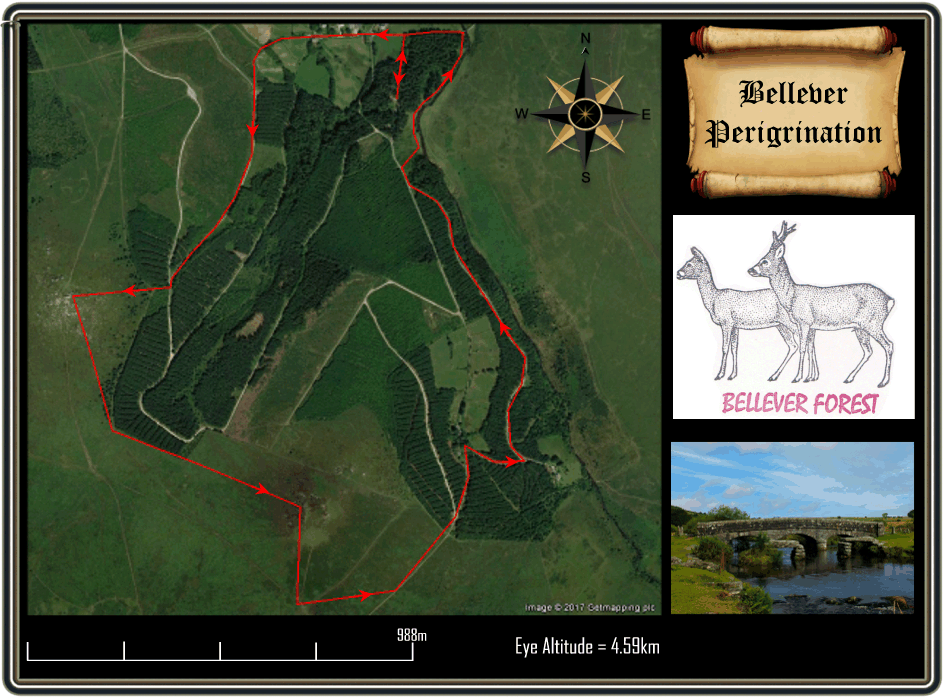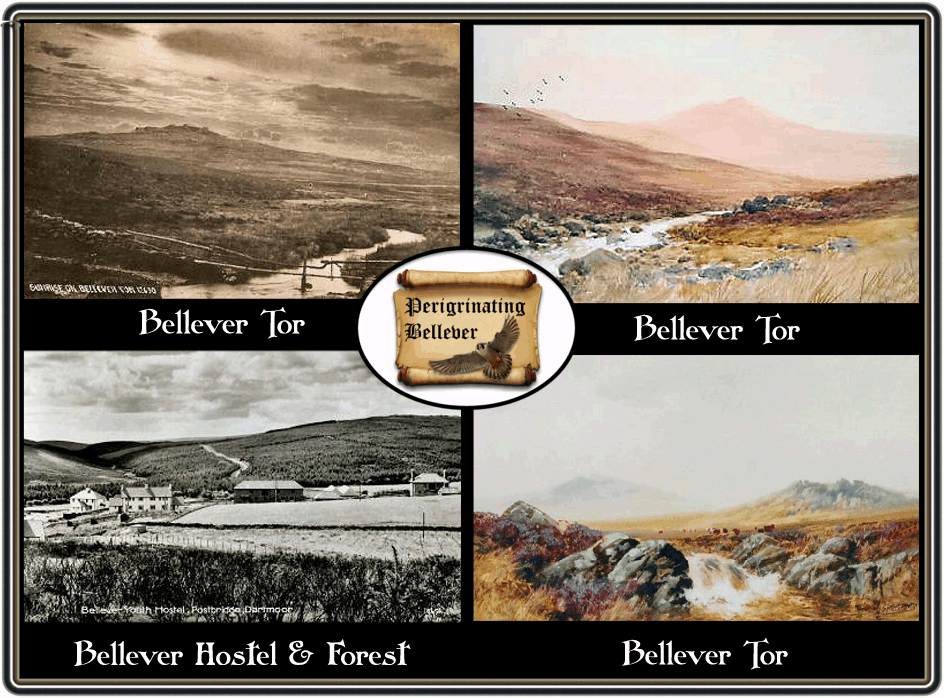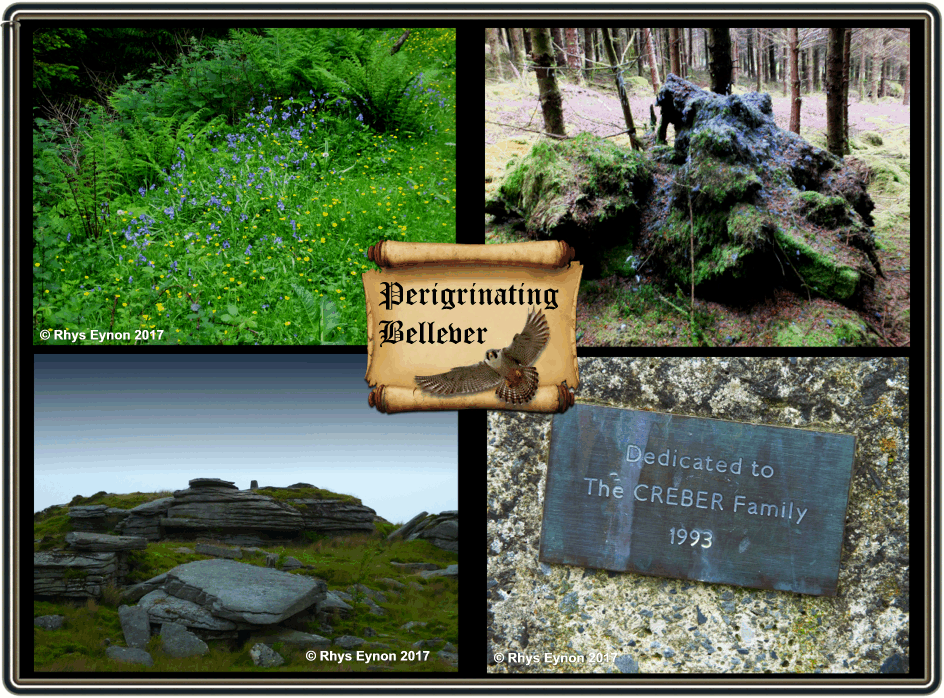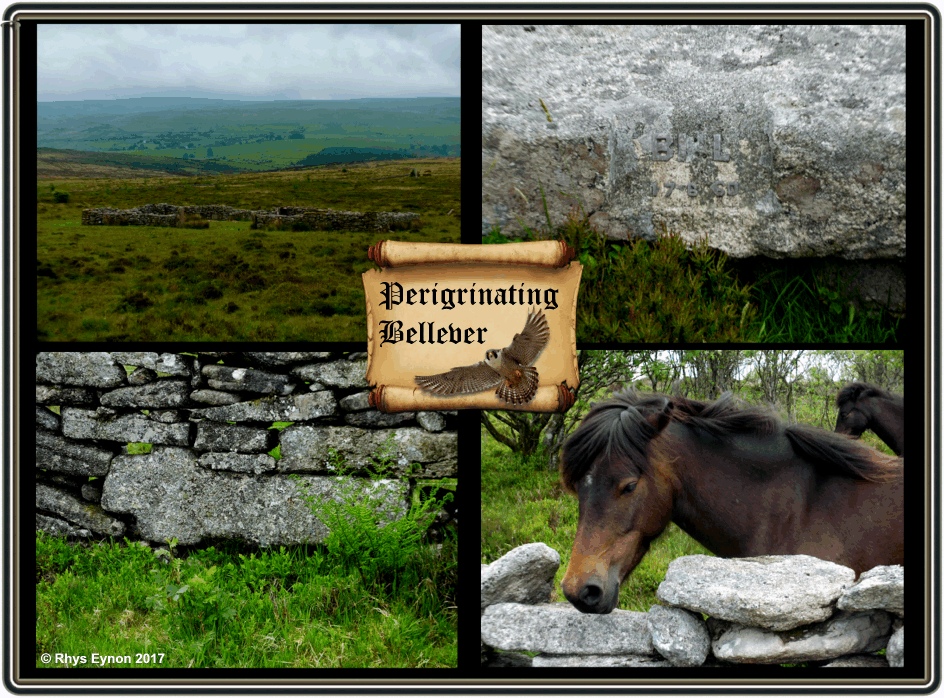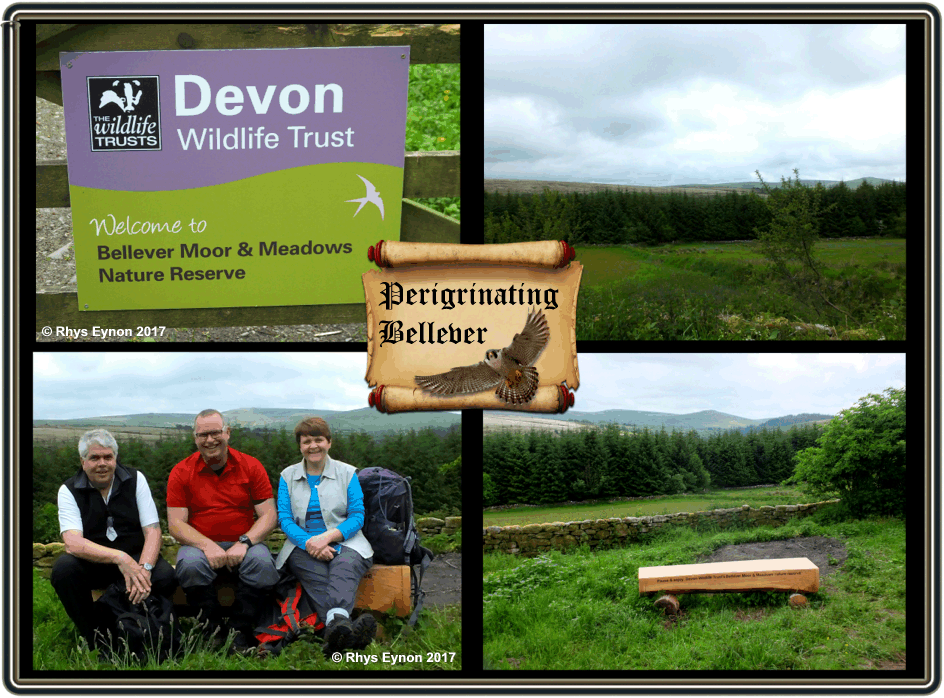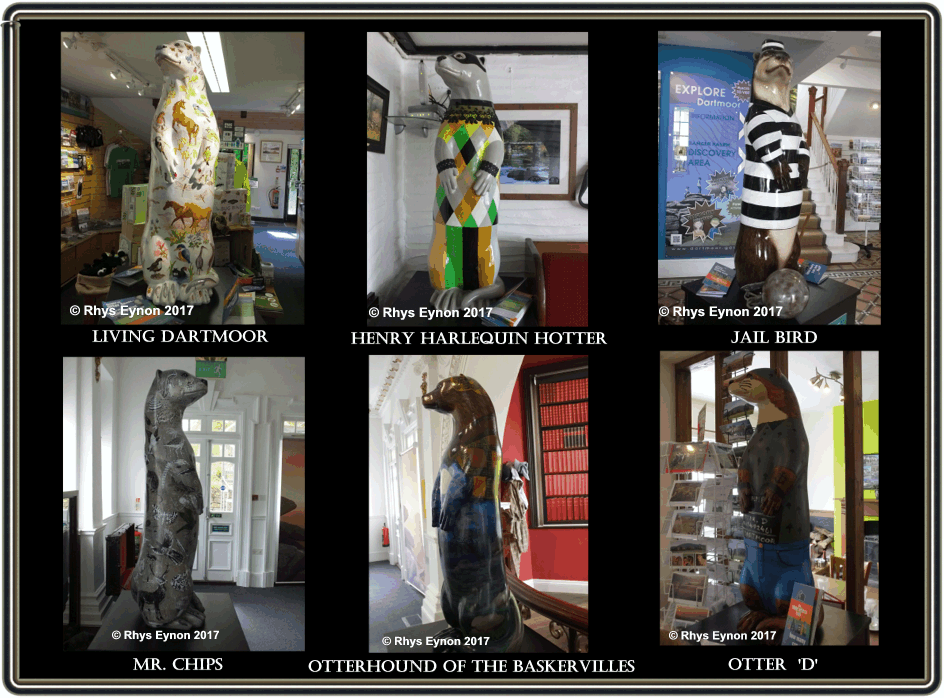
“O Bellever tor is a dainty tor:- ‘Tis neither high or low: – But all the world loves Bellever, for: -‘Tis the place the piskies know.
You see the sun on Bellever when – The rest of the moor is clad – In a rain cloak spun by the fays of the fen, When the piskies all run mad.”
Peregrinating Bellever, I literally came across the word ‘peregrinating’ today, it’s a late 16th century word that is defined as “to travel or wander from place to place.” That is exactly what this Xploration is a wander around Bellever Forest from place to place. There are those who say that Bellever tor is the dead centre of Dartmoor, personally I would say the centre point is north of the tor on Lakehead Hill. Either way there can be no question that there are some awe inspiring views to be seen from its summit. The ‘Bellever Complex‘ which surrounds the tor is packed full of prehistoric buildings and ritual features as is the smaller nearby ‘Laughter Tor Complex‘. It is several years since I last took a peregrination of the area (2006 to be exact) and as the surrounding area is an ever changing landscape (due to the de-forestation) it was about time for another visit. What has changed is the information you can now get from the Forestry Commissions’ free iPhone app called the ‘Forest Xplorer’ and the £2 parking charge (which I think is fair enough as what else could you get for £2 that would provide a day’s entertainment). The day chosen for this was the last day of May, mainly because the weather forecast was seemed to be the only half decent day of the week.
“Liar, liar, your’s pants are on fire,” – the cloudy day with sunny outbreaks as promised by the weather folk did not materialise, well not until 2.00 pm anyway. At 10.00 am. we were greeted with ‘drizzmist’, that very fine misty rain that has the ability to penetrate the most waterproof of clothing. “Liar, liar, your’s pants are on fire,” – it now costs £3 to park the car not the £2 as stated on their website and above. Apart from that Louise, Rhys and myself were thoroughly looking forward to a spot of peregrinating through the deserted forest. The route we took can be seen above and in all honesty it matters not if you do it widdershins or deosil. The first thing we came across was the Bellever YHA a place that brought back memories of bringing my junior archaeology club down to for the weekend. At one time the YHA complex was a Duchy Farm, famous for breeding amongst other things ‘The Bulls of Bellever‘, these were two Scottish breeds; the Aberdeen Angus and the Galloway breeds. The road running past the hostel belongs to the ancient corpse road known as the Lych Way and would be used by the inhabitants of the ancient tenements for getting to the church services at Lydford. This also meant that any burials also had to take place at Lydford which entailed carrying the coffin or body along the arduous route which was around 12 miles in good weather but 17 in bad weather. Just past the last fields of Bellever Farm the road becomes divided into two tracks with the Lych Way leading straight on uphill and a left-hand branch going through the plantation. As we were headed for Bellever Tor we swung left and peregrinated through the trees, the bluebells were defiantly making their last stand of the season and where they grew amongst the buttercups made an eye-catching contrast. Having walked the track for about a kilometre a junction was reached with another track coming in from the right. It is at this point where Bellever Tor sits high above the trees and was where we needed to be. Sadly there was no path leading up to Bellever Tor so it was a case of pick a forest ride and begin the steep haul up to the moor. Whilst stumbling through the brash a large brown bird carefully threaded its way through the tress and out onto the moor. It soon became apparent what the buzzard was doing amongst the trees, as can be seen from the photo below it was eating its breakfast on its favourite feeding post. By the amount of fur and feathers this bird was a particularly efficient hunter who enjoyed dining under the wooded canopy. Once onto the open moor there then followed another steep climb up to Bellever Tor.
Bellever Tor.
“On a day in early spring, the world from Bellaford Tor was draped in the east wind’s mantle. Milky hazes wrapped the horizon and washed the moor with pale light, through which Dart glimmered like a metal thread and wound amid her marshes, her hills and naked woodlands. Larks shrilled in the pale sunlight and plovers called. The wind sang drily in the dead rushes on the hill-top, and above, great separate clouds were scattered in a long procession from east to west.” Eden Phillpotts, The River, p.256.
There can be no question that on clear day the views from Bellever Tor are vast and breathtaking but the granite piles have other associations apart from the geology and archaeology. It has been suggested that the name Bellever is associated with Baal the pagan sun god and a story about him is told in the Bellever Hobbyhorse. As the little poem at the top of the page suggests it was/is one of the famous Dartmoor piskies haunts as proven by the legend of the farm boy Tom White who was unfortunate enough to become Piskie-Led.
The Ordnance Survey have given the tor the accolade of being a viewpoint due the the outstanding 360 degree panoramas, unfortunately on this particular day it was not living up to its reputation due to the low cloud cover. Visible for miles around is the old iconic Trig Point which sits on top of the tor. For those into trig points this one on Bellever is OSGB36 Station – SX76/T1 and sits at a height of 443.788 metres. The pillar has a plaque attached to it which read; “Dedicated to the CREBER Family – 1993.”
Leaving behind the granite bastions of Bellever Tor we made our way down and over to Laughter Tor on the way we met another walker who brusquely asked where we were going, having replied; “only over to Laughter Tor,” he grunted and added; “oh, that’s alright then.” Glad to have had your approval sir!
Laughter Tor.
“On Laughter Tor I stood and marked the Bair Down range and the high peaks crowned by Longaford’s cone. Beneath me roamed East Dart, and upon the west broke great Mis Tor, like the peak of a ragged cloud. Here and there a copse lay upon the expanse and stretched in a dim smudge of darker green above the scattered granite and dun herbage. Under Crockern, the tin miners’ meeting-place of old, there spread a cluster of trees, and Prince Hall’s plantations stretched nearer at hand, with West Dart throwing a silver loop about them. Beneath me lay the tiny homesteads of Dunnybridge and Brownberry.” Eden Phillpotts, The Judge’s Chair, p. 1 – 2.
In the vicinity of Laughter Tor you have various locations that adopt the ‘Laughter‘ place-name and one could be forgiven for thinking what a strange name. However, in 1362 the tor was documented as being Laddretorre, the two elements being Laddre and Torre. The place-name Society suggest that the word Laddre comes from the Cornish Celtic word ledr meaning slope or cliff which would give the ‘Sloping or cliff-like Tor’, Glover et. al, p.195. In addition, the tor and its surrounding landscape features have also been known as Lough/Laugh Tor by many of the noted topographical writes such as William Crossing, Eric Hemery etc. There are local stories of strange and mysterious goings-on around Laughter Tor, some say it’s a favourite spot of the piskies. An amusing newspaper report appeared in 1934 regarding the Chagford Women’s Institute Choir and their annual moonlight outing on Dartmoor. Apparently they made their way up to the tor and sung ‘Jerusalem’. But during the recital one of the members saw a mysterious light suddenly appear and another member spotted ‘something white moving nearby. It was at this point the conductor decided it was time to make a rapid departure before it became too dark.
One hundred metres due south of Laughter Tor is a square enclosure which can clearly be seen on aerial photographs taken from 2.5 kilometres above. This is known as ‘The Sheep Measure‘ or Sheep Tell and its purpose was to allow the farmers to quickly count their sheep. They had a rough idea of how many sheep the enclosure would hold when full so it was just a matter of driving the sheep into the measure and then counting how many times it was filled.
On a small chiselled out recess on the edge of a bench-like slab which sits between the two main outcrops of Laughter Tor is/was a small memorial that contains the inscription ‘Bill 17?6-6? made from lead letters. This apparently refers to Bill Mudge who once lived at nearby Huccaby and this particular spot was where he would like to sits and contemplate his lot whilst admiring the view. On the left-hand outcrop I spotted what looked like a letterbox site on a ledge halfway up the face which Rhys had already found. Here was another memorial plaque which read; “XX – DON – 2. 2. 35 TO 31.50.08.”?
Just over 150 metres north west of the tor was another surprise, on the northern side of the enclosure wall can be seen the remnants of what appears to be a partially completed granite cross built into the lower sections of the wall. How or when it got there is a complete mystery and is why I’ve called it the Laughter Tor Mystery Cross. When viewed from the southern side there was no hint of the cross which makes me think it’s a partially completed cross. It was at this point we met the herd of ponies belonging to the Dartmoor Pony Heritage Trust, it is only when you see such fine ponies as these you realise how far away from the breed the other wild ponies have become. It also becomes apparent why the many signs dotted around the Bellever Forest ask the public to ensure all access gates are kept closed in order to stop them mixing with the other moor ponies. From the pony herd our journey then took us downhill to rejoin the forest track which led on to Laughter Hole Farm. Much of the old farm fields have now been leased by the Forestry Commission to the Devon Wildlife Trust on a twenty five year basis and is called ‘The Bellever Moor and Meadow Nature Reserve’. This 72 acre reserve is the newest addition for the Devon Wildlife Trust and has SSSI status. It recently received support from the SUEZ Community Trust which has allowed for various improvements to the reserve and its infrastructure. One such improvement is the wooden bench shown in the photo below. The land is a beautiful patchwork of traditional hay-meadows, wet grassland and moorland. On this visit the fields were full of buttercups, bluebells and copious amounts of Cuckoo Spit with foxgloves just beginning to come into flower lined alongside the old granite walls. If you would like to know more about life at Laughter Hole Farm and its surrounds I cannot recommend enough Jez Wilkinson’s book – ‘The Well Watered Land’ which is about his life growing up on the farm during the mid 1990s.
Once through the reserve we headed back towards the car park and on approaching its nearby surrounds one would have been forgiven for thinking they were approaching Blackpool Beach. There were small groups of picnickers, children playing in the river and folk just wandering, a complete contrast to to solitude of the above tors. Having completed the walk it was decided that some well earned refreshment was needed and so we headed off back towards the East Dart Hotel. Now there is an art trail that has just been launched on and around Dartmoor and it’s called the ‘Moor Otters Trail‘ This consists of one hundred, three foot, decorated otter statues which have been placed in various pubs, hotels, cafes, DNP Visitor Centres, tourist attractions and local businesses. The idea being that people can go on a pilgrimage to find them all. So, as there was one located in the nearby Postbridge Visitor’s Centre we began a mini otter hunt. It was with great anticipation we all grabbed our cameras and headed off to the centre. No walk would be complete without at some point my camera battery going flat and true to form it was a flat as the proverbial witch’s tit. Thank the lord Rhys had his camera. Now I will not spoil the fun but at every otter ‘holt’ there is the statue, a donation box and a splendid booklet listing all the venues where the otters can be spotted and photographs of them all. The Postbridge otter was a fantastic piece of artwork called ‘Living Dartmoor’ and it was here we were rewarded with an ‘I’m an Otter Spotter‘ sticker, well to tell the truth Rhys was, I declined the offer. Having spotted ‘Living Dartmoor‘ we then moved on to the East Dart Hotel to find ‘Henry Harlequin Hotter’ and to spot a bit of lunch. Henry Harlequin Hotter turned out to be as flamboyant as the barman who to me was the Dartmoor version of Little Britain’s Daffyd, what a character and there certainly was not a dull moment when he was around. Having wined and dined or rather ale and ate we moved on over to Princetown to spot a few more otters. Being the flagship visitors centre Princetown had the honour of playing host to no less than three otters; Jail Bird, Mr. Chips and Otterhound of the Baskervilles. Out of the three I think Jail Bird was the best as he stood some a mere eight hundred metres from the prison. The fourth otter at Princetown was located in the Fox Tor Cafe and was called ‘Otter ‘D‘. The main purpose of these otters is to raise a target figure of £100,000 which will go towards future Dartmoor conservation projects. The funds will come from two sources, donations in the otter plinths and in September all one hundred will be auctioned off, so at least please donate if you go otter spotting. There is an opportunity to enter a competition by finding twenty otters along with their individual otter codes and submitting an entry form which can be found in the otter trail booklet. So ends our peregrinating Bellever Xploration.

Phillpotts, E. 1902. The River. New York: Frederick A. Stokes Co.
Phillpotts, E. 1914. The Judge’s Chair. London: John Murray.
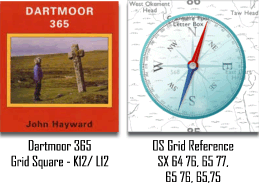
 Legendary Dartmoor The many aspects past and present of Dartmoor
Legendary Dartmoor The many aspects past and present of Dartmoor


